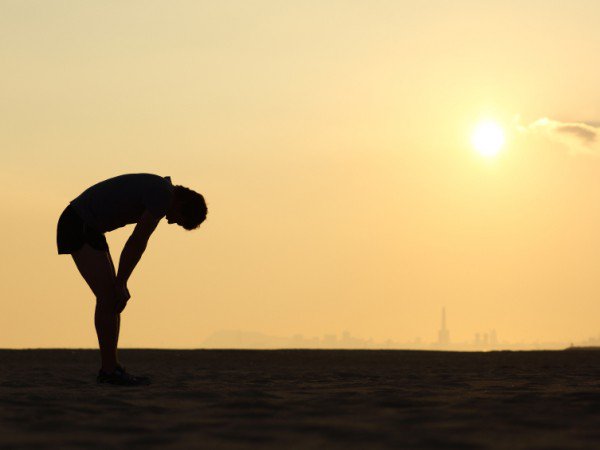
The summer season comes with longer days and more frequent outdoor exercise activity which means whether you’re riding your bike with the family or training for a half marathon, it is wise to understand how the heat and humidity affects your body. Let’s take a look at the signs and symptoms of heat illness and how to exercise safely this summer.
For most people, the perfect temperature for exercise is around 55-65 degrees. This is especially true when participating in consistently moderate to high intensity activity like running. I say most people because everyone is different and there are some people that can thrive in the warmer temperatures (but those are far and few between).
For instance, when my team ran in the Chicago Marathon in October, 2007 (the hot one), the temperatures rose to 90 degrees and the humidity was in the 90% range. All of the runners but one suffered from the heat (499 people to 1) and their times were on average 45 – 90 minutes off their normal marathon times. It’s also important to note that many medications can affect the cooling system in the body so it’s important to talk to your doctor or pharmacist about your medicinal protocol as it relates to the heat.
You can’t beat the heat, but you can learn to work with it.
When the temperatures are in this optimal exercise zone, your body neither has to keep itself warm in the colder temperatures or work hard to cool itself via sweating, blood redistribution and panting. It’s the Goldilocks “just right” temperature and allows the body to efficiently cool itself as you move.
However, as the temperature and humidity rise above this range, your body has to invest more energy into keeping you cool. And because the body cools itself via evaporation in your sweat, the higher the relative humidity, the harder it is for your body to cool itself. When the heat gain exceeds the level your body can deal with, your body core temperature rises and this is when you are at greater risk of developing heat-related illness.
Heat Cramps. These are the mildest form of heat-related illness and commonly occurs in the diaphragm, calves, hamstrings and even your extremities (hands, feet, etc.) You may have a mild fever (102 F) and your skin flushed. This is often related to the heat, and a higher level of sweat loss (fluid and electrolytes) your body is producing while exercising.
- What to do for Heat Cramps: If this happens, it is important to cease exercise, move into a cool space (shade or indoors) to cool the body and hydrate with an electrolyte beverage (sports drink, tomato juice, salted pretzels), place cool clothes on body or take cool shower (or pool), and remove layers of clothing.
- What to do for Heat Exhaustion: Stop activity, get out of the heat, and cool body with wet towels or cool water submersion to reduce body temperature, lie down and elevate feet, drink electrolyte drink, and if there are no signs of improvement, call 911 to get medical help.
- What to do for Heatstroke: Call 911 or your local medical service immediately! Get out of the sun and into a cool place, remove all clothing and put ice in the armpits and groin or immerse in cold water and drink cool electrolyte beverage if coherent.
- Acclimate and move by effort rather than speed. It takes about two weeks for your body to acclimate to exercising more efficiently in the warmer weather, and even then can still be a challenge. It’s important to recognize this at the change of seasons like springtime, and invest in easier effort activity until your body has time to adjust to the temperatures. It’s also important to run by your body rather than the speed on your watch or bike. If you normally run a moderate effort run on Wednesdays at a 9 minute per mile pace, run by your body instead and let the outcome be just that – the outcome. It will likely be slower than normal, but adjusting to the heat will allow your body to better recover down the road. When you exercise by what your body is experiencing on the given day, you’re better able to dial in the correct and optimal zone to accomplish your goal for the day and adapt much more efficiently workout to workout.
- Adjust your exercise time and location. Plan your exercise route on tree-covered, shaded streets, paths or trails and get in your workout in the early morning or at dusk when the temperatures are lower. Take your workouts indoors on Ozone or Heat Alert days as you’ll get in a higher quality workout with no risk of heat illness or the delayed recovery that often follows hot weather workouts. This is especially important for athletes following a specific training program as a delayed recovery can have a domino effect in fatigue and greatly reduce their performance.
- Accessorize and hydrate. Wear light-colored, loose-fitting wicking apparel that will deflect the sun’s rays and allow for better body cooling. Visors are effective for keeping the sun off your face while still allowing heat to leave your body via your head. Top it off with a good sweat proof sunscreen and sunglasses and you’re set for the workout. It’s better to hydrate consistently through the day than to power load your body with a lot of fluids before, during and after. Everyone has their own unique hydration needs and they vary on your fitness, health, age, medications and more. Dr. Tim Noakes, exercise physiologist and author of Waterlogged, recommends hydrating to your thirst during exercise to avoid over drinking and the complications that come with it. Water is the perfect beverage for workouts under an hour, where a sports drink with electrolytes will benefit you more for longer sessions.

